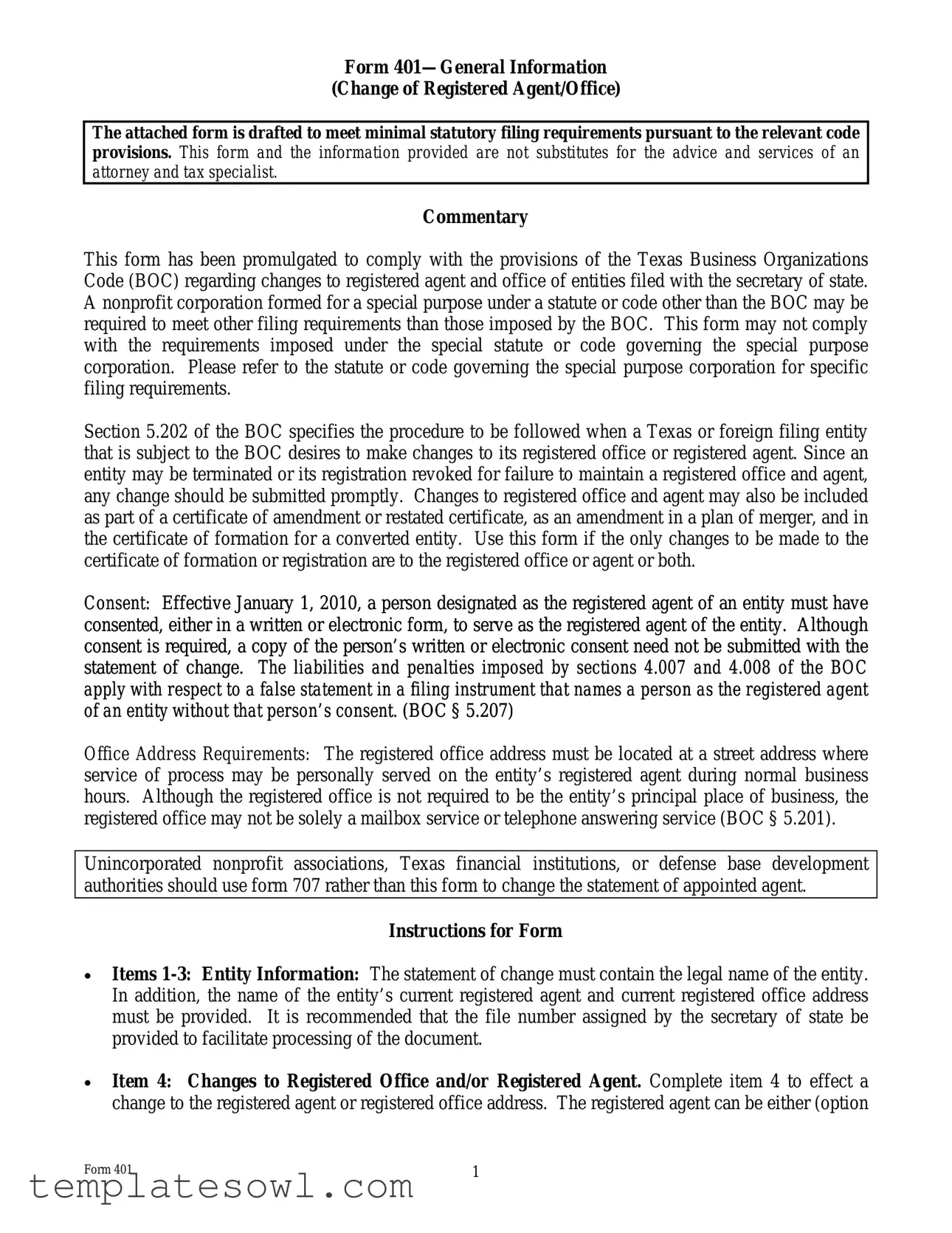A)a domestic entity or a foreign entity that is registered to do business in Texas or (option B) an individual resident of the state. The filing entity cannot act as its own registered agent.
If the registered office is changed, complete section C. The registered office must be located at a street address where service of process may be personally served on the entity’s registered agent during normal business hours. Although the registered office address is not required to be the entity’s principal place of business, the registered office may not be solely a mailbox service or a telephone answering service (BOC § 5.201).
The statement of change must recite that the street address of the registered office is the same as the registered agent’s business address.
Statement of Approval: As required by section 5.202(b)(6) of the BOC, the form includes a recitation that the change specified in the statement is authorized by the entity. While the statement of change has the effect of amending the entity’s certificate of formation or registration, the BOC does not provide that the procedures to amend the certificate of formation are applicable. In general, the statement of change should be adopted and approved by the governing persons or by a person authorized to act on behalf of the entity.
Effectiveness of Filing: A statement of change becomes effective when filed by the secretary of state (option A). However, pursuant to sections 4.052 and 4.053 of the BOC the effectiveness of the instrument may be delayed to a date not more than ninety (90) days from the date the instrument is signed (option B). The effectiveness of the instrument also may be delayed on the occurrence of a future event or fact, other than the passage of time (option C). If option C is selected, you must state the manner in which the event or fact will cause the instrument to take effect and the date of the 90th day after the date the instrument is signed. In order for the instrument to take effect under option C, the entity must, within ninety (90) days of the filing of the instrument, file a statement with the secretary of state regarding the event or fact pursuant to section 4.055 of the BOC.
On the filing of a document with a delayed effective date or condition, the computer records of the secretary of state will be changed to show the filing of the document, the date of the filing, and the future date on which the document will be effective or evidence that the effectiveness was conditioned on the occurrence of a future event or fact.
On acceptance of the statement of change by the secretary of state, the statement is effective as an amendment to the appropriate provision of the entity’s certificate of formation or the foreign filing entity’s registration.
Execution: Pursuant to section 4.001 of the BOC, the statement of change must be signed by a person authorized by the BOC to act on behalf of the entity in regard to the filing instrument. Generally, a governing person or managerial official of the entity signs a filing instrument.
The statement of change need not be notarized. However, before signing, please read the statements on this form carefully. The designation or appointment of a person as the registered agent by a managerial official is an affirmation by that official that the person named in the instrument has consented to serve as registered agent. (BOC § 5.2011, effective January 1, 2010)
A person commits an offense under section 4.008 of the BOC if the person signs or directs the filing of a filing instrument the person knows is materially false with the intent that the instrument be





 This document becomes effective when the document is filed by the secretary of state.
This document becomes effective when the document is filed by the secretary of state. This document becomes effective at a later date, which is not more than ninety (90) days from the date of signing. The delayed effective date is:
This document becomes effective at a later date, which is not more than ninety (90) days from the date of signing. The delayed effective date is:
 This document takes effect upon the occurrence of a future event or fact, other than the passage of time. The 90
This document takes effect upon the occurrence of a future event or fact, other than the passage of time. The 90